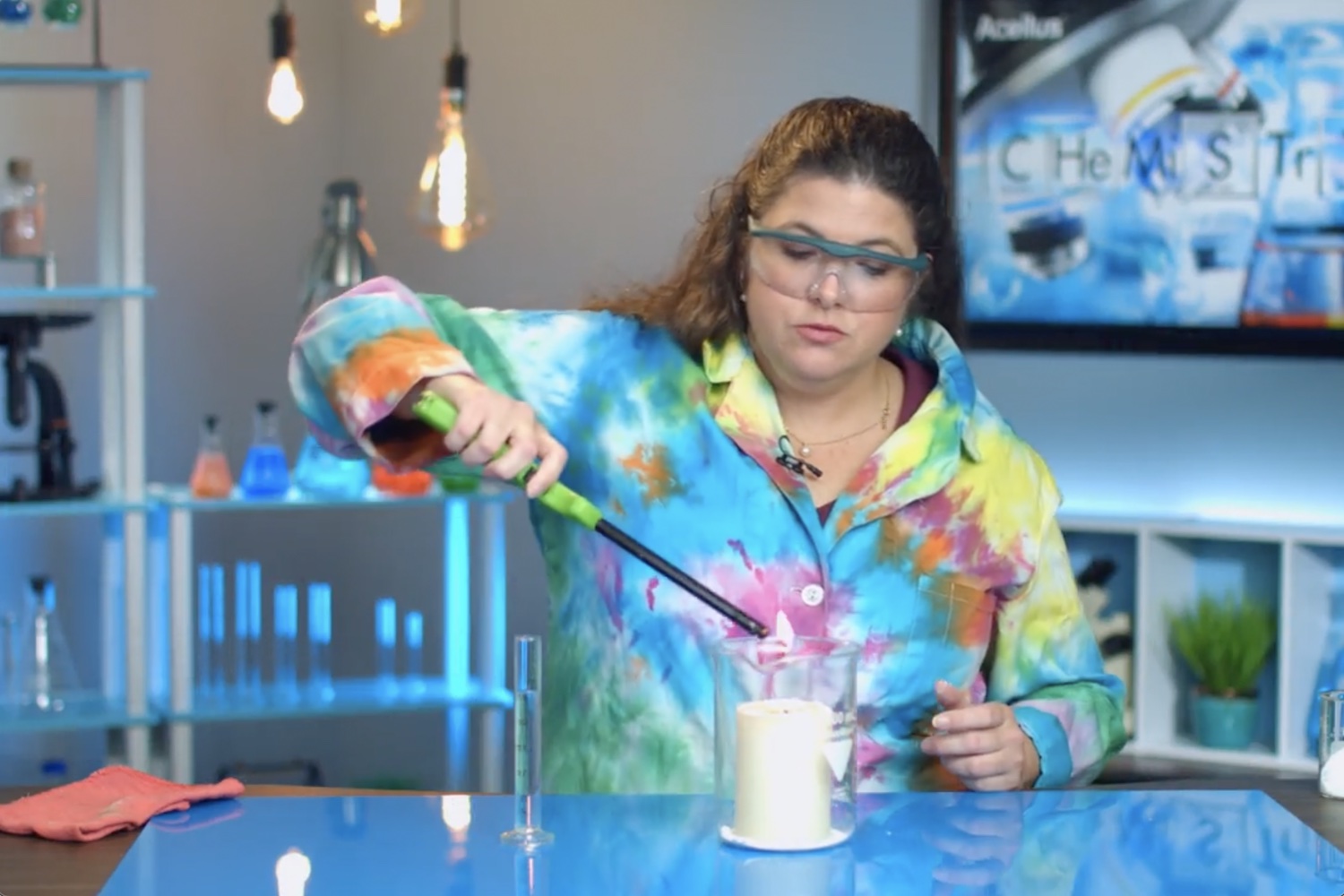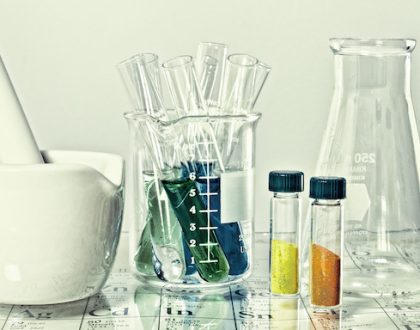General Chemistry

Course Features
Course Details
Course Overview
Acellus General Chemistry provides students with an introduction to the fundamentals of chemistry. Students build data analysis, critical thinking, and science communication skills while exploring various forms of matter, the composition of the atom, and organization of the periodic table. They will learn about properties of matter and use patterns to predict the behavior of atoms undergoing chemical reactions. They will understand chemical bonding and other interactions between atoms and molecules. They will explore the laws of conservation of mass and energy through calculations, including stoichiometry and calorimetry. Acellus Chemistry is taught by Nicole Lyssy. Students should take this course concurrently with, or after taking, Algebra II or Integrated Math III.
Sample Lesson - Exploring the World
 This course was developed by the International Academy of Science.
Learn More
This course was developed by the International Academy of Science.
Learn More
Scope and Sequence
Unit 1: Chemistry Is a Laboratory Science This unit discusses basic laboratory principles including various scientific models, lab equipment, lab safety, and the fundamentals of designing a scientific experiment. Students will also learn how to properly collect, analyze, measure, and report data. Unit 2: Math for Chemistry In this unit, students will learn important fundamental mathematics concepts such as SI units, derived units, scientific notation, metric prefixes, dimensional analysis, unit conversion, and significant figures. Unit 3: Matter and Change This unit investigates matter -- how to identify it, its physical and chemical properties, and various states. Physical and chemical changes on microscopic, macroscopic, and representative forms are explored. Students will learn about safety data sheets commonly used in scientific laboratories. They will be introduced to common separation techniques. This unit also takes a first look at the periodic table, the implications of the law of conservation of mass, identifying types of mixtures, and calculating the percent by mass of a given compound. Unit 4: The Building Blocks of the Universe This unit explores the early atom and electron models, along with the discovery of alpha, beta, and gamma radioactive particles. This unit also covers isotopes, and atomic and molar mass. Students will also learn about nuclear stability and decay, fission and fusion, and how to define each type of radiation in terms of mass, charge, penetrating and ionizing power. Unit 5: What's in an Atom? This unit delves into radiation in our world, the photoelectric effect, spectra, the Bohr model, and the quantum mechanical model of the atom. Students will also perform calculations involving electromagnetic radiation, Planck’s constant, energy, and the speed of light. The latter part of this unit primarily focuses on fundamentals of quantum mechanics including electron shells, subshells, orbitals, the Aufbau Principle, Hund’s Rule, the Pauli Exclusion Principle, electron configuration, valence electrons, and Lewis dot structures. Unit 6: The Best Cheat Sheet Ever This unit characterizes different groups within the periodic table. Students will learn how to identify metals, nonmetals, and metalloids. They will investigate the importance of valence electrons. Students will also learn important periodic trends associated with atomic and ionic radii, ionization energy, and electronegativity. Unit 7: Chemical Bonding - Ionic and Metallic Bonds This unit discusses the common properties of ionic and metallic bonds. Students will also learn to name and write the formulas for binary, multivalent, polyatomic, and metallic ionic compounds. Unit 8: Chemical Bonding - Covalent Bonds This unit covers common properties of covalent bonds. Students will learn the names and formulas of various compounds. Also included are Lewis structures, resonance, VSEPR, as well as bond and molecule polarity. Unit 9: Chemical Reactions In this unit, students will learn how to recognize, write, balance, and classify various chemical reactions as redox, synthesis, decomposition, single or double replacement, or combustion. This unit also introduces the activity series and solubility rules. Unit 10: The Mole This unit explores the concept of the mole and introduces students to Avogadro’s number. Students will also learn how to determine the empirical and molecular formulas for substances and how to calculate percent composition. Unit 11: Stoichiometry In this unit, students will learn basic stoichiometry to perform calculations involving chemical reactions. Students will perform mole to mole, mole to mass, and mass to mass calculations. They will learn how to determine the limiting reactant and how to calculate percent yield. Unit 12: Gases In this unit, students investigate gases. They begin by exploring kinetic molecular theory, pressure, and Dalton's law of partial pressure. Later in this unit, students learn how to perform calculations involving the various gas laws: Boyle's law, Charles' law, Gay-Lussac's law, Avogadro's law, the combined gas law, and the ideal gas law. Unit 13: States of Matter This unit covers various intra- and intermolecular forces and the effect they have on matter. Students learn about the properties of liquids and gases. They study changes in phase and learn to use phase diagrams. Unit 14: Solutions In this unit, students will learn about different types of solutions. They will study the energy associated with the solvation process. They will explore the electrolyte capacity of various compounds and explore factors affecting dissolving rate and the amount of solute dissolved under various conditions. Unit 15: Solution Mathematics In this unit, students will learn to calculate percent by mass and volume. They will learn to calculate molarity and molality of solutions as well as concentrations in parts per million and parts per billion. They will learn how to perform dilution calculations. In the latter part of this unit, students explore the colligative properties of matter as they perform boiling point elevation and freezing point depression calculations. Unit 16: Energy In this unit, students consider the various types of energy present in a system. They learn about the thermochemical laws of energy and explore energy transfer and thermal equilibrium. Students learn to use specific heat in calculations. They learn how to interpret reaction diagrams and how to write thermochemical equations. Unit 17: Reactions Rates and Equilibrium In this unit, students learn how to interpret concentration versus time graphs to describe the rate of a reaction. Students consider various factors affecting reaction rates and the role of catalysts and inhibitors. In addition, dynamic equilibrium is considered and LeChatelier's Principle explained. By the end of this unit, students will be able to compare methods for optimizing a reaction to produce the greatest benefit in terms of cost and environmental effect. Unit 18: Acids and Bases After reviewing acid naming, in this unit students learn how to identify an acid or base using the Arrhenius and Bronsted-Lowry models. They explore the properties and consider the strengths of acids and bases and are introduced to the pH scale. Students become proficient performing pH calculations. They will be able to predict the products of an acid-base neutralization reaction. Following this unit students are presented with the Final Review and Exam.
This course does not have any sections.





